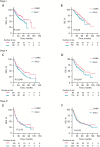Comparison of clinicopathologic features and prognosis between surgically resected pulmonary large-cell neuroendocrine carcinoma and small-cell lung cancer
- PMID: 40400949
- PMCID: PMC12090107
- DOI: 10.21037/jtd-2025-345
Comparison of clinicopathologic features and prognosis between surgically resected pulmonary large-cell neuroendocrine carcinoma and small-cell lung cancer
Abstract
Background: Pulmonary large-cell neuroendocrine carcinoma (LCNEC) and small-cell lung cancer (SCLC) are classified as types of high-grade neuroendocrine carcinoma (HGNEC). The aim of this study was to determine the similarities and differences in clinical features and prognosis between LCNEC and SCLC.
Methods: We retrospectively compared the clinical features and prognosis of LCNEC and SCLC, along with well as their two subtypes, including pure LCNEC (P-LCNEC) and combined LCNEC (C-LCNEC) and SCLC combined with LCNEC and SCLC combined with non-LCNEC, respectively. Disease-free survival (DFS) and overall survival (OS) were calculated using the Kaplan-Meier method.
Results: We included 341 patients with LCNEC and 580 patients with SCLC who underwent surgical treatment. Significant differences in smoking history, primary site, tumor location, pathological (p) N stage, pTNM stage, and visceral pleural invasion (VPI) were observed between LCNEC and SCLC groups (all P values <0.05). The subgroups of LCNEC (P-LCNEC and C-LCNEC) and SCLC (SCLC/LCNEC and SCLC/non-LCNEC) displayed differences in smoking history, primary site, tumor location, pT stage, pN stage, pTNM stage, VPI, adjuvant chemotherapy, and postoperative adjuvant radiotherapy. LCNEC and its subtypes P-LCNEC and C-LCNEC were associated with superior DFS and OS than were SCLC and its subtypes SCLC/LCNEC and SCLC/non-LCNEC (DFS: P=0.008, P=0.001, P=0.049; OS: P=0.005, P=0.005, P=0.006). Compared to patients who did not receive adjuvant chemotherapy, those with stage I SCLC or LCNEC who underwent adjuvant chemotherapy demonstrated a significantly improved DFS (P=0.005 and P=0.048) and OS (P=0.004 and P=0.03).
Conclusions: LCNEC and SCLC, as well as their subtypes, have distinct clinical features and survival outcomes. SCLC exhibited more malignant biological behavior and was associated with a worse prognosis compared to LCNEC. Postoperative chemotherapy is recommended for patients with stage I HGNEC.
Keywords: Pulmonary high-grade neuroendocrine carcinoma (pulmonary HGNEC); large-cell neuroendocrine carcinoma (LCNEC); pure and combined subtypes; small-cell lung cancer (SCLC).
Copyright © 2025 AME Publishing Company. All rights reserved.
Conflict of interest statement
Conflicts of Interest: All authors have completed the ICMJE uniform disclosure form (available at https://jtd.amegroups.com/article/view/10.21037/jtd-2025-345/coif). R.A.R. has received consulting fees from ITM Radiopharma, Regeneron, TerSera Therapeutics, Exelixis, Novartis, and Lantheus, serves on the speakers bureau for AstraZeneca, and is an unpaid Board of Directors member for the North American Neuroendocrine Tumor Society. The other authors have no conflicts of interest to declare.
Figures




Similar articles
-
Comparative Study of Pulmonary Combined Large-Cell Neuroendocrine Carcinoma and Combined Small-Cell Carcinoma in Surgically Resected High-Grade Neuroendocrine Tumors of the Lung.Front Oncol. 2021 Sep 22;11:714549. doi: 10.3389/fonc.2021.714549. eCollection 2021. Front Oncol. 2021. PMID: 34631540 Free PMC article.
-
Different Characteristics and Survival between Surgically Resected Pure and Combined Pulmonary Large Cell Neuroendocrine Carcinoma.Ann Surg Oncol. 2022 Sep;29(9):5666-5678. doi: 10.1245/s10434-022-11610-4. Epub 2022 May 11. Ann Surg Oncol. 2022. PMID: 35543906 Review.
-
Clinical and Pathologic Differences between Small-Cell Carcinoma and Large-Cell Neuroendocrine Carcinoma of the Lung.Ann Surg Oncol. 2024 Sep;31(9):5697-5705. doi: 10.1245/s10434-024-15505-4. Epub 2024 May 29. Ann Surg Oncol. 2024. PMID: 38811497
-
Disparity in clinical outcomes between pure and combined pulmonary large-cell neuroendocrine carcinoma: A multi-center retrospective study.Lung Cancer. 2020 Jan;139:118-123. doi: 10.1016/j.lungcan.2019.11.004. Epub 2019 Nov 11. Lung Cancer. 2020. PMID: 31775086
-
Update on large cell neuroendocrine carcinoma.Transl Lung Cancer Res. 2017 Oct;6(5):530-539. doi: 10.21037/tlcr.2017.06.12. Transl Lung Cancer Res. 2017. PMID: 29114469 Free PMC article. Review.
References
LinkOut - more resources
Full Text Sources
